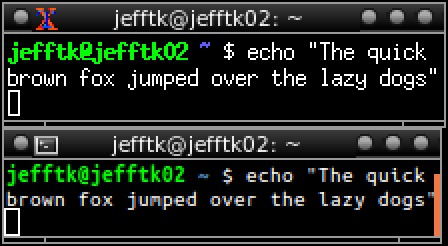Work Desktop Setup |
December 1st, 2016 |
| tech |
- browser on one monitor
- tile the rest of the space with tall terminals
- put some extra terminals for starting jobs etc off on the side
This looks like:

(This is divided over two monitors, with the browser and the first vertical terminal on the left-hand monitor.)
I spent an embarrassingly long time having to hand-configure this each
time I had to restart my computer, and avoiding restarting as much as
possible to keep from having to do this, so I eventually learned how
to use -geometry arguments to set this up:
# Make the background black. Not that # the background should ever be visible # or anything. fbsetroot -solid black # Start and place terminals. 81 columns # because code here is limited to 80 # columns and emacs reserves a column for # the wrapping indicator. uxterm -geometry 81x90+1428+0 & uxterm -geometry 81x90+1920+0 & uxterm -geometry 81x90+2412+0 & uxterm -geometry 81x90+2904+0 & uxterm -geometry 73x22+3396+0 & uxterm -geometry 73x22+3396+310 & uxterm -geometry 73x22+3396+620 & uxterm -geometry 73x19+3396+930 & google-chrome & # Start the window manager last, and # don't run it in the background. fluxbox
Update 2018-02-08: I just got new monitors, both 2560x1440, so I now have 5120x1440 of space to work with. I'm not sure exactly how I want to set it up, but for now I have:
uxterm -geometry 81x109+2560+0 & uxterm -geometry 81x109+3052+0 & uxterm -geometry 81x109+3544+0 & uxterm -geometry 81x109+4036+0 & uxterm -geometry 79x8+4528+0 & xclock -geometry 108x108+5010+0 & uxterm -geometry 97x25+4528+128 & uxterm -geometry 97x25+4528+476 & uxterm -geometry 97x25+4528+824 & uxterm -geometry 97x19+4528+1172 &
I also used to manually adjust the settings on xterms each
time I started them up, but then I learned how to use xrdb.
I put xrdb -l ~/.Xdefaults in my .xsession, which
contains:
xterm*metaSendsEscape: true xterm*reverseVideo: on xterm*visualBell: False
I also have pretty strong preferences about how fonts should look.
Specifically, unless I'm in a hidpi environment, I don't want the
modern thing where you use a vector-graphics based (true type) font
and then through some combination of hinting and antialiasing you fit
it to the screen. Instead I want precisely pixel-aligned bitmap
fonts, which happens to be exactly what xterm uses by
default.
What am I talking about? Here's a zoomed-in view comparing
xterm with its default font to gnome-terminal with
its default one:

The gnome-terminal rendering isn't terrible, especially when
you're at a normal zoom level, but it's much less crisp than the
xterm rendering.
(This is one of the things that makes ssh-from-a-browsers annoying: I don't believe there's any way to get text to render device-pixel-perfect, so until hidpi displays are everywhere you can't get away from the blurry fonts there. This is much less of an issue for ordinary web text than terminal text, because I run my terminals at a much smaller font size to get as much as possible on the screen at once.)
Comment via: google plus, facebook, substack